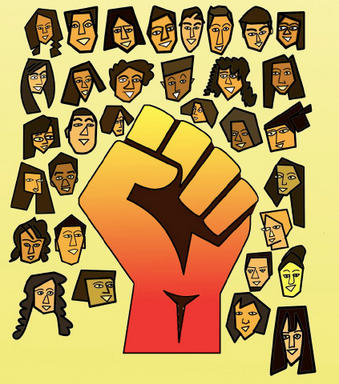
Hmong and LatinA/o/X Testimonios:
The Pedagogical Space Between



Testimonio is a process for sharing life stories that centers the individual voices and collective experiences of historically marginalized individuals
Image description: Image of a fist surrounded by youth faces of varying races. Image created by Pranav Sood. BACKGROUND IMAGE IS A STOCK IMAGE OF ROLLING GREEN HILLS.
By AGnelia, libertY, and Tianna
with support from Kate Roberts, Taucia González, Mariana Pacheco, and Joan Hong
Introduction
Hmong and Latina/o/x high school students have varying academic experiences and outcomes, but we know that schools have yet to tap into their full potential to meet their needs. Many of the constraints to fully supporting Hmong and Latina/o/x learners have to do with limited and/or deficit understandings of the strengths, dreams, aspirations, needs, and systemic barriers they face and navigate in their educational pursuits (Ladson-Billings, 2005; Taylor, Gillborn, & Ladson-Billings, 2009; Valencia, 2012). Even available research specific to these two groups may not adequately represent the full range of marginalization that these students confront on a day-to-day basis (e.g., Marrero, 2016; Vue, 2021).
One pedagogical tool that invites youth to reflect critically on their experiences with marginalization are testimonios, which is a genre of writing that centers on individual and collective counternarratives that challenge master narratives about marginalized communities. Testimonios can be thought of as a process and/or a product. The process of testimoneando requires youth to identify particular experiences and events that shaped their perceived and lived marginality (Delgado Bernal et al., 2012). Though we present testimonios here as products, or pedagogical tools, we also share glimpses into our process of coming together to support youth in the process of creating their testimonios. Here, three youths narrate their testimonios to create a pedagogical space for teachers, administrators, and researchers to learn and take action in their own contexts.
Testimonios, originating from Latin America, are a form of writing centers the voices, as well as individual and collective experiences, of historically marginalized individuals. Delgado Bernal et al. (2012) explain that testimonios are about “giving voice to silences, representing the other, reclaiming authority to narrate, and disentangling questions surrounding legitimate truth” (p. 365). It is also a process involving critical reflection and writing to more fully enact social change through collective stories, histories, and struggles.
TESTIMONIOS: FROM PROCESS TO PRODUCTS
As a group, instructors and youth spent four weeks unpacking the oppression and marginalization that youth had witnessed and/or experienced in their everyday lives. Aside from the youth testimonialistas sharing their testimonios, other roles helped to facilitate the testimonio-making process. For instance, the adults’ roles in this publication was that of interlocutors, or as education allies helping to document the youth’s testimonios in the ways that they preferred (e.g., on video, through audio, with visuals that made sense to them). You, the educators and administrators, also play an important role in testimoneando. Though the youth gained a lot from the process of reflecting critically and writing their testimonios, they did not write them solely for themselves. They wrote them to affect social change. Thus, their testimonios can be taken up as a pedagogical space for you, the listener, to be able to learn, to step into someone else’s experiences, and to experience knowledge and truth that encompasses more than abstract ideas—bodies, emotions, histories, experiential knowledge. Building on the work of Lenkersdorf (2008), Delgado et al. (2012) conceptualize the act of listening as follows:
No matter what form a testimonio takes, listening is central to the pedagogical practice of testimonio. Hearing a testimonio is not the same as listening to a testimonio… As a listener, another’s testimonio is much like a gift—the listener unwraps the testimonio to reveal the heart of the matter. In doing so, the listener’s responsibility is to engage the testimonialista in an effort to understand… In this space of exchange between listener and testimonialista, we are able to open doors into another’s world, open hearts and minds and at times, become invited participants—we become emparejados —aligned, next to each other, in solidarity.
With this brief introduction to the testimonios, we invite you to enter the pedagogical space of testimonio open to you as an opportunity to learn, exchange, reflect, and take action in solidarity with these youth.

The testimonios
Image description: the silhouette of two adults outside holding hands on either side of a child.
Image description: a white dove flying on a black background.
Image description: the silhouette of a child looking upwards with white light beaming from behind.

AGNELIA's Testimonio
For captions, text appears on slides. Video includes youth-selected images.

LIBERTY'S TESTIMONIO

Tianna's Testimonio

references
Delgado Bernal, D., Burciaga, R., & Flores Carmona, J. (2012). Chicana/Latina testimonios: Mapping the methodological, pedagogical, and political. Equity & Excellence in Education, 45(3), 363-372.
Ladson-Billings, G. (2005). Evolving role of critical race theory in educational scholarship, the. Race Ethnicity and Education, 8(1), 115-119.
Marrero, F. A. (2016). Barriers to school success for Latino students. Journal of Education and Learning, 5(2), 180-186.
Taylor, E., Gillborn, D., & Ladson-Billings, G. (2009). Foundations of critical race theory in education. Routledge.
Valencia, R. R. (2012). The evolution of deficit thinking: Educational thought and practice. Routledge.
Vue, R. (2021). Trauma and resilience in the lives and education of Hmong American students: Forging pedagogies of remembrance with critical refugee discourse. Race Ethnicity and Education, 24(2), 282-301.

